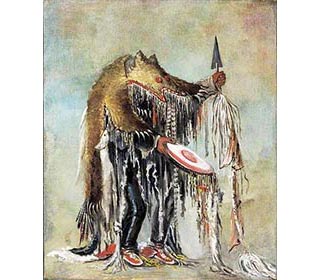The term 'Shamanism' is derived from the Sanscrit word "sraman" meaning a worker or toiler. Shamanism is not a specific religion but a doctrine based on a belief that physical nature might be brought under the control of man. Shamanism prevails among American Indian tribes and blends with their varied religious beliefs, rituals, ceremonies and customs. The doctrine associated with Shamanism is probably one of the oldest beliefs of man, with its origins probably dating back to the Stone Age. Shamanism and Spirits
The belief in spirits was fundamental to Shamanism. The fundamental belief in Shamanism is that Nature is alive and every object is controlled by its own independent spirit or soul. Spirits inhabit the sky, stars, sun, moon, rivers, lakes, mountains, forests, trees, plants, animals, insects, fish, flowers and birds. Some spirits are good and help men who please them whereas other spirits are bad and liable to wreck havoc and harm on people and on tribes. It is the bad spirits that cause trouble, suffering, sickness, death and disease. Shamanism, Medicine, Mystery and Shamans
Some believe that when a man is ill a bad spirit has taken away his soul or has entered into him. It is therefore not surprising that the Native Indians would wish to gain power over these spirits. In Shamanism a man with knowledge of spirits and the supernatural was called a Shaman. Shamans would know protective words and chants and have knowledge of objects which, if carried, would disarm bad spirits and protect their owner. Such knowledge is what the Native American Indians mean by “medicine” or “mystery.” The Native Americans who spent their lives in trying to gain such knowledge are referred to as medicine men, medicine people, mystery men, or Shamans. Shamanism is encompassed in a range of Native American Beliefs
Shamanism is not a religion as such but is mixed with other beliefs such as Animism, that, taken as a whole have strong religious connotations. The idea and concept behind Shamanism is that people have a spiritual connection with animals, supernatural creatures and all elements of nature. Shamanism was part of a range of beliefs of the tribes of Native American Indians that also included: - Animism - Animism is a belief based on the spiritual idea that the universe, and all natural objects within the universe, have souls or spirits. It is believed that souls or spirits exist not only in humans but also in animals - refer to Animal Totems and Power Animals
- Fetishism - Fetishism is a subordinate branch of animism encompassing the doctrine of spirits embodied, attached or conveying influence through, certain animals or material objects
- Ritualism & Ceremonialism the use of ancient practises, rituals and ceremonies to further existing beliefs and Spiritual Healing
- Totemism - Totemism was practiced by Northwest Indian tribes and centered around the belief of having a natural object or animate being, such as as a bird or animal, as the emblem of a family, clan, or tribe. Totemism encompassed a system of tribal organization according to their totems
The concepts of Shamanism, Totemism, Ritualism, Animism and Fetishism should all be considered to gain a full understanding of the religious beliefs of the Native American tribes who practised Shamanism. Shamanism and Animism - Animal Totems and their Meanings
The belief in Shamanism is prevalent in many Native Indian Tribes. There might be some regional and tribal variations to their beliefs in Shamanism but there are several common features that are shared by all forms of Shamanism: - Spirits exist and they play important roles in the lives of individuals and in the well-being of the tribe
- Spirits can be good or bad
- Shamanism is part of a belief system that also incorporates elements of beliefs in Animal Totems as spirit guides, omens, and message-bearers
- Shamans (men with knowledge of spirits and the supernatural)
- Communicate with the spirit world
- Treat sickness caused by malevolent spirits
- Use trance-inducing methods and techniques to produce a Trance State and incite tribe members and go on Vision Quests
- Leave the body and enter the supernatural world to search for answers
- Perform various forms of divination
- Wear symbolic regalia and use sacred objects in Shamanistic ceremonies and rituals
Shamanism and the Mound Builders
The ancient Mississippian culture of the Mound Builders of North America were part of the Southeastern Ceremonial Complex of American prehistory (S.E.C.C.) who embraced Shamanism. The Mississippian Native Americans were the last of the mound-building cultures of North America in the Midwestern, Eastern, and Southeastern United States. Some Native Indian tribes still retain some elements of the Mississippi culture, including Shamanism. A shaman was a spiritual leader and healer of the Mississippian Indians who believed that within the Shamanism creed that the shaman communicated with spirits in other worlds. Shamans used dances, gestures and sounds as the symbolic powers of Shamanism to enter the spirit world. Shamans wore ceremonial clothes and carried sacred objects such as rattles and drums to incarnate the spirits of nature and amplify their power. The ancient Shamans of the Mississippian Indians also used masks that were believed to hold spiritual powers and would identify them with the spirits and activate their power. For additional Information on Shamanism refer to the article on the Shaman Symbol. |
